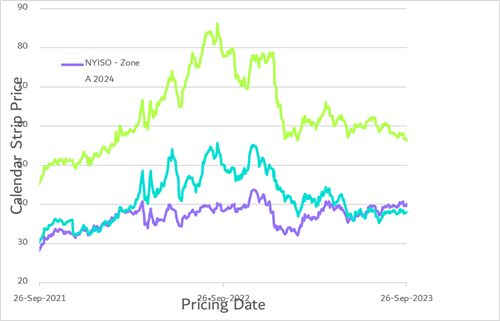Smartest Insight | Issue 136

Our weekly company round-up covers the key market and industry news in one place, so you don’t have to look any further to stay ahead.
September 27, 2023
Market Update:
Natural gas storage reported for the w/e Sep 15th a build of 64 BCF compared to expected build of 63 BCF. The market quickly responded by dropping $0.10, to $2.62 for the prompt month. Today, the Oct contract expires making Nov the prompt month. Currently a $0.20/MMBtu spread between the two.
The 8/14 day forecast continues its warmer than normal trend for the eastern 2/3rds of the U.S. Winter forecasts leans heavily toward a warmer winter.
Heading into Autumn the markets remained steady. Prompt month has traded between $2.50-$3.00/MMBtu with the 3 month forecast leaning bearish.
Power prices have slowly crept up. The power markets are holding their premium with WS Elliott on our minds. Any hint of colder temps well send markets up. The market seeks any reason to go up. If weather doesn't show up, the market will be happy to keep most of that premium.
The storage expectation for the week ending September 28th is for a build of +85 BCF.

Regulatory Report:
Consideration for Voluntary Energy Market in PJM
A group of states within PJM Interconnection is working on creating a voluntary forward energy attribute market by the year-end, separate from PJM's existing power markets. This move aims to allow states to pursue their clean energy goals independently. The Organization of PJM States Inc. (OPSI) will collaborate with PJM to develop and implement this forward clean energy market. A draft charter from the Forward Energy Attribute Market Working Group highlights the high priority of creating this market to efficiently decarbonize PJM's grid and meet public policy objectives.
This initiative comes as PJM stakeholders have shown limited interest in the Integrated Attribute Capacity Market and Forward Energy Attribute Market, prompting this separate effort. The working group's goal is to present a fully developed Forward Clean Energy Market design and implementation strategy by the end of 2023. However, questions about the Federal Energy Regulatory Commission's (FERC) jurisdiction over this new market remain. The impact on PJM markets is also uncertain, and discussions are ongoing regarding the products to be procured.
Despite some uncertainties, the working group is actively progressing toward the establishment of the forward clean energy market, with public meetings scheduled for October, November, and December. Meanwhile, PJM staff plans to recommend discontinuing the Clean Attribute Procurement Senior Task Force, as it has completed its designated tasks.
US Inflation Reduction Act: States' Success Key to Green Energy Innovation and Emission Cuts
The US Inflation Reduction Act (IRA), signed into law by President Joe Biden in August 2022, focuses on reducing greenhouse gas (GHG) emissions and spurring innovation in clean energy and transportation manufacturing. The success of this legislation will depend on how effectively states leverage the tax credits and incentives it offers. The IRA allocates $60 billion for clean energy manufacturing, establishes tax credits for nuclear power, hydrogen, and energy storage, and includes provisions for power transmission.
Experts emphasize that the IRA recognizes that clean energy policy will be shaped by individual states, giving them the flexibility to pursue their own paths toward a net-zero emissions goal by 2050. The US Department of Energy's Loan Programs Office supports state-led initiatives and aligns federal priorities with those of states through its financing programs.
While the IRA has incentivized clean energy manufacturing and innovation, it falls short in addressing non-technical barriers to transmission and distribution system growth, interconnection queues, and permitting processes. Some experts argue that additional funding is needed to strengthen the transmission and distribution infrastructure.
Overall, the IRA's success hinges on how states navigate its incentives and tailor their clean energy strategies, recognizing that state-level initiatives are pivotal in achieving GHG reduction and clean energy goals.
